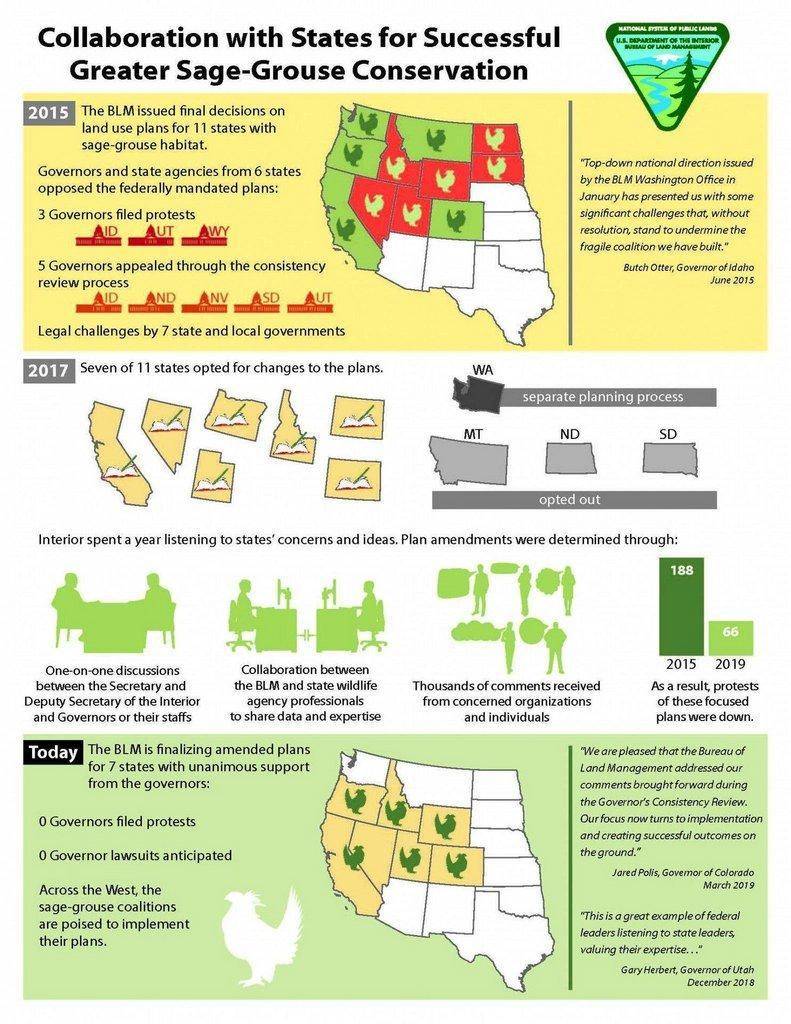BLM News Release
Collaboration with states addresses conservation without stifling local economies
WASHINGTON – Furthering the Administration’s goals of restoring trust with local communities and responsibly developing America’s natural resources while easing regulatory burdens, the Bureau of Land Management today issued Records of Decision (RODs) amending land use plans for Greater Sage-Grouse habitat management on public lands, providing special protective measures for nearly 60 million acres of sagebrush steppe.
The decisions received bipartisan support from the governors who sought revisions to the plans that guide conservation of sagebrush steppe habitat on BLM-administered public lands in their respective states. The goal was to better align BLM plans for managing habitat with state plans for conserving the species.
“Months of close coordination and cooperation with state governments in Wyoming, Nevada, California, Idaho, Oregon, Utah and Colorado have gone into the development of today’s decisions,” said Acting Secretary of the Interior David Bernhardt. “The plan amendments adopted today show that listening to and working with our neighbors at the state and local levels of government is the key to long-term conservation and to ensuring the viability of local communities across the West.” [See article: Governors welcome plan revisions]
“This new BLM plan improves upon the 2015 federal sage-grouse plans by incorporating the best available science and aligning with the State’s 2019 Conservation Plan for Greater Sage-Grouse,” said Utah Governor Gary Herbert. “I support BLM’s ongoing efforts to work with the State, and other stakeholders, to conserve, enhance, and restore sage-grouse habitats throughout Utah. The State of Utah remains committed to working with BLM, and the Department of Interior to implement this revised BLM plan to manage sage-grouse habitats in Utah.”
“Since the very beginning of this effort, all partners have maintained the need to conserve the sage grouse and avoid the need to list the species as threatened or endangered,” said BLM Deputy Director for Policy and Programs Brian Steed. “We also share a commitment to conservation that does not put the West’s communities at risk and which balances between regulation and access. We believe that the better outcomes for the species under these plans will demonstrate the value of coordinating federal and state authority.”
The decisions affect resource management plans for BLM-administered public lands in seven Western states, where the BLM manages habitat and states manage wildlife species. Together, the amended BLM plans retain the priority habitat designation (PHMA) for more than 29 million surface acres of BLM-administered sagebrush-steppe, where the management priority is to exclude or avoid disturbance to sage-grouse and their habitat, and to minimize effects where PHMA cannot be avoided. Another 23 million surface acres rangewide retain identification as general habitat (GHMA), where avoidance and minimization are applied flexibly, in line with local conditions and a state’s science-based objectives for species management. The plans covering BLM-managed lands in Utah do not designate any GHMA.
Including 3.4 million acres of PHMA and 2.4 million acres of GHMA in Montana and the Dakotas – whose BLM sage-grouse plans are not being amended – a total of 32.4 million surface acres will be managed as priority habitat across the Greater Sage-Grouse’s range, while another 25.6 million surface acres are designated general habitat. The plans for BLM lands in Nevada, Idaho and Colorado include additional habitat categories, acreages and management objectives specific to their respective states.
In Utah, amendments to 14 BLM plans will increase flexibility in applying stipulations to portions of designated habitat management areas (HMAs) that are not currently serving as active habitat, and when improved outcomes are expected to result, caps on disturbance and density may be exceeded. Altogether, there are 7.3 million acres of sage-grouse habitat mapped across the state.
Benchmarks, or “trigger” points, for local sage-grouse populations remain in place for BLM-managed habitat to indicate when adaptive management measures are needed to address population declines. The amended plans also outline procedures once it is determined that a decline has been stopped and reversed.
The plans build on those put into place in 2015. In 2017, the BLM began scoping for the new plans asking whether “some, none or all” of the 2015 sage-grouse plans should be amended. Seven of 11 affected states asked for changes, and the BLM and the Department of the Interior worked with each to design range-specific modifications.
The decisions also formalize coordination between the BLM and respective states in applying mitigation measures to approved actions. The state-specific arrangements recognize that the BLM does not have authority to require compensatory mitigation for otherwise allowable activities on public lands while supporting each state’s plan and authorities for mitigation.
The planning effort that concludes with Thursday’s decision began in 2017 when governors of most of the affected sage-grouse states asked the BLM to revisit existing plans for managing sage-grouse habitat and adapt them to better meet the needs of individual states. In response, the BLM proposed changes developed in collaboration with governors and state wildlife agency professionals in the seven affected states, as well as other concerned organizations and individuals, largely through the Western Governors Association’s Sage-Grouse Task Force.
The decisions reflect the BLM’s determination that greater flexibility was needed to manage habitat and respond to the particular needs of each state’s landscapes and communities.
The decisions and supporting documents will be available online https://goo.gl/7wdKmM.

